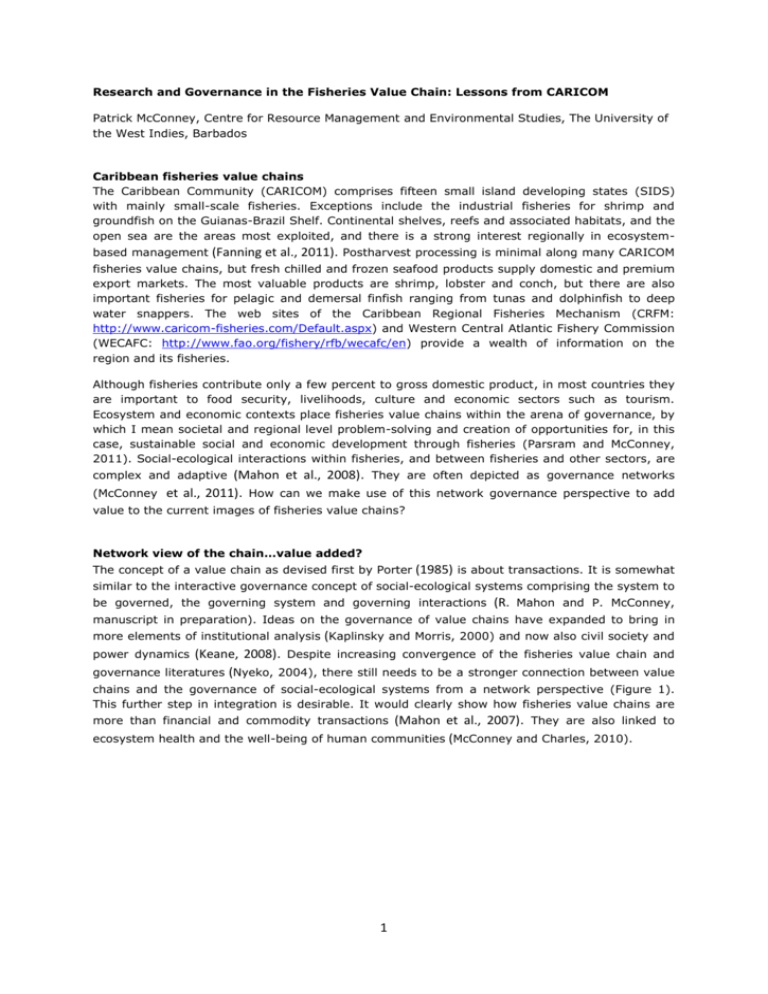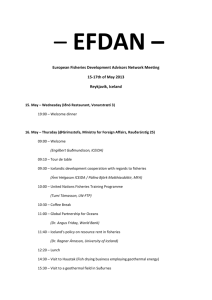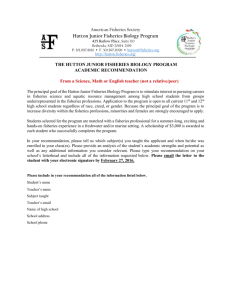Caribbean fisheries value chains
advertisement

Research and Governance in the Fisheries Value Chain: Lessons from CARICOM Patrick McConney, Centre for Resource Management and Environmental Studies, The University of the West Indies, Barbados Caribbean fisheries value chains The Caribbean Community (CARICOM) comprises fifteen small island developing states (SIDS) with mainly small-scale fisheries. Exceptions include the industrial fisheries for shrimp and groundfish on the Guianas-Brazil Shelf. Continental shelves, reefs and associated habitats, and the open sea are the areas most exploited, and there is a strong interest regionally in ecosystembased management (Fanning et al., 2011). Postharvest processing is minimal along many CARICOM fisheries value chains, but fresh chilled and frozen seafood products supply domestic and premium export markets. The most valuable products are shrimp, lobster and conch, but there are also important fisheries for pelagic and demersal finfish ranging from tunas and dolphinfish to deep water snappers. The web sites of the Caribbean Regional Fisheries Mechanism (CRFM: http://www.caricom-fisheries.com/Default.aspx) and Western Central Atlantic Fishery Commission (WECAFC: http://www.fao.org/fishery/rfb/wecafc/en) provide a wealth of information on the region and its fisheries. Although fisheries contribute only a few percent to gross domestic product, in most countries they are important to food security, livelihoods, culture and economic sectors such as tourism. Ecosystem and economic contexts place fisheries value chains within the arena of governance, by which I mean societal and regional level problem-solving and creation of opportunities for, in this case, sustainable social and economic development through fisheries (Parsram and McConney, 2011). Social-ecological interactions within fisheries, and between fisheries and other sectors, are complex and adaptive (Mahon et al., 2008). They are often depicted as governance networks (McConney et al., 2011). How can we make use of this network governance perspective to add value to the current images of fisheries value chains? Network view of the chain…value added? The concept of a value chain as devised first by Porter (1985) is about transactions. It is somewhat similar to the interactive governance concept of social-ecological systems comprising the system to be governed, the governing system and governing interactions (R. Mahon and P. McConney, manuscript in preparation). Ideas on the governance of value chains have expanded to bring in more elements of institutional analysis (Kaplinsky and Morris, 2000) and now also civil society and power dynamics (Keane, 2008). Despite increasing convergence of the fisheries value chain and governance literatures (Nyeko, 2004), there still needs to be a stronger connection between value chains and the governance of social-ecological systems from a network perspective (Figure 1). This further step in integration is desirable. It would clearly show how fisheries value chains are more than financial and commodity transactions (Mahon et al., 2007). They are also linked to ecosystem health and the well-being of human communities (McConney and Charles, 2010). 1 Governing system Environmental NGOs Tourism interests Governing interactions System to be governed ecosystem Public health Fisher folk organisations Responsible fisheries code Biodiversity conservation International trade agency Fisheries authority Seafood standards Eco-labelling Trade laws New gear harvest Consumer watchdog processing consumer Typical extent of value chain analysis Fishery as a complex adaptive social-ecological system Figure 1. Network governance perspective on the fisheries value chain A key feature of this perspective is that a sustainable fisheries value chain and livelihoods must be founded upon good ecosystem health. Seafood processing, marketing and trade can impact upon ecosystem health either positively or negatively through practices ranging from harvest technology to meet specific market needs to the waste disposal practices onshore. For highly migratory species, and those with wide larval dispersal, the impacts can be transboundary and this requires a regional or international (multi-level) perspective on fisheries governance. In ecosystem-based management, the stakeholders are diverse. Several economic sectors and types of stakeholders need to be linked to the policy domain for governance to be efficient and effective. So how do these network perspectives help in developing fisheries value chains that contribute to sustainable social and economic development? A network governance perspective assists in thinking more broadly about how transactions in one realm are connected to outcomes in another, perhaps distant, area. Realms and areas refer not only geospatially to places but also to legalinstitutional arrangements and virtual communities that span the globe in this era of globalisation. The network perspective situates fisheries value chains in their social-ecological contexts. This aids the analysis of lateral and vertical linkages that can inform design and implementation of development-oriented governance interventions. Multi-level network governance of fisheries value chains Tuna fisheries provide examples for examining the multi-level network governance of fisheries value chains. These fisheries are immensely important to ACP SIDS in the Pacific and vital to Indian Ocean and Caribbean Sea SIDS. Tunas are harvested by both large and small-scale fisheries. Looking ahead ecologically, links from international to local level include the likely impacts of anthropogenic climate change and variability on the pelagic ecosystem that will become coupled with changing patterns in international trade mediated through the value chain. For example, physical infrastructure for fish landing and handling now has to take sea level rise and coastal inundation models into account for getting fish to market otherwise supplies for export will be affected. Other links concern the capacity of the small fisheries authority to interface with the international management of tunas on the one hand, and the well-being of fisherfolk households scattered around the coast on the other. Because an authority has limited capacity, it may partner 2 with non-governmental organisations (NGOs) that range from local fisheries cooperatives to global conservation groups, thereby respectively adding civil society linkages for production and ecolabelling for marketing. Connections are diverse in this brief and simplified example of how governance networks impact upon the value chains of tuna fisheries. Many factors and relationships need to be taken into account to develop these fisheries. Doctoral researcher Kemraj Parsram is investigating social and governance networks related to fish marketing in Grenville, Grenada, where much of the catch is blackfin tuna. He is finding that the value chain is highly adaptive and very much dependent on the social networks of fisherfolk which in turn interface with governance networks such as the management of the fish marketing facilities and role of the fishermen’s cooperative. No examination of the blackfin tuna value chain is complete without understanding how these networks function to move fish from the boats to consumers. Source: Kemraj Parsram, CERMES, UWI, unpublished data For highly valuable reef-associated species such as spiny lobster and queen conch the commercial fisheries not only run the length of the chain from ecosystem to international marketing, but they also interface in many locations with marine protected areas (MPAs) aimed mainly at tourism revenue-earning and biodiversity conservation. The value chain may acknowledge tourism as a marketing asset. However, this narrow perspective may not take into account the fuller implications of governance such as when decisions which displace fishers (e.g. as a result of zoning no-take areas or building hotels and marinas) result in reduced seafood supplies even as the local demand may be expanding because of tourism. Such inter-sectoral linkages that may affect value chains are made explicit in ecosystem-based management within social-ecological system networks. Patrick McConney and others have engaged in participatory action research into MPA governance in Belize, Grenada, Jamaica, St Lucia and St Vincent and the Grenadines. Fishers see MPAs as both very beneficial in the long run but quite threatening to their livelihoods and well-being in the short to medium term. Fisher organisations are increasingly taking political collective action to ensure that they are not marginalised by tourism-oriented biodiversity conservation. They are working with both governmental and non-governmental partners to maintain fisheries value chains, particularly at the local level, and avoid the situation of increasing fish imports substituting for sustainable local catch. Source: Patrick McConney, CERMES, UWI, unpublished data Sea urchin fisheries are important in a few countries such as Barbados, Grenada and St. Lucia. These resources are very valuable for domestic markets, but are easily overfished. One of the drivers of overfishing is the thriving market for illegally harvested product. The lure of high prices exceeds the fear of small penalties for illegal harvest, and the cultural acceptance of poaching nullifies concerns over social sanctions being applied at the community level. From a governance perspective, this short value chain is dominated by the legal-institutional regime of property rights, ethics and societal norms associated with the urchin fisheries. These fisheries tend to be boom and bust, with open seasons of high production punctuating multi-year closures of the fisheries given low urchin abundance. Illegal fishing maintains this low abundance and prevents the fisheries from being opened for legal commercial harvest. Addressing compliance and enforcement is one of the ways in which better fisheries governance may assist in developing the value chain through more consistent harvests. Unless societal tolerance of illegal harvest is addressed, there will be little development. Doctoral researcher Shelly-Ann Cox is comparing the sea urchin fisheries of Barbados and St. Lucia in terms of their potential for adaptive co-management. She is using a network governance perspective and finding that social networks based on sharing ecological knowledge and trust are important for understanding the harvest regimes, including illegal harvest, and how the urchins are marketed in and out of the closed season. The fisheries authorities are aware of the illegal harvest, but also aware that immediate concerns of poverty and limited occupational mobility constrain the realistic fishery management options. Stakeholders in the fishery are looking to 3 insights from a network governance perspective to recommend new institutional arrangements for a viable, legal fishery. Source: Shelly-Ann Cox, CERMES, UWI, unpublished data Lessons learned and future directions What lessons can be learned from these or other examples of how fisheries value chains can be viewed in new light from a network governance perspective? What are the directions for future research and development in this area? The Caribbean Large Marine Ecosystem (CLME) Project (http://www.clmeproject.org/portal/default.aspx) analyses transboundary marine resource governance on an ecosystem basis that conceives of fisheries as complex adaptive socialecological systems. Although value-chain analysis is not a large part of the project, we are learning how fisheries livelihoods and governance are closely connected. Developing value chains, particularly in a changing climate, has a lot to do with being adaptive and self-organising in smallscale fisheries. For this to happen there must be enabling fisheries policy. Fisherfolk organisations in CARICOM are being strengthened and networked as part of such enabling policy in order to build adaptive capacity and promote self-organisation that is transboundary and multi-level. Fishers in these organisations are developing value chains by promoting responsible fisheries in order to get better quality and more sustainable harvests. Fisherfolk are entering the fisheries policy arena at multiple levels to get their voices heard. At times this is to help develop the fisheries value chain in concert with the region’s major economic sector – tourism. Strategies range from ensuring that MPA designation does not unduly displace fishers to ensuring that “fish fry” ventures (which prepare fish for sale) succeed in providing fishing households with opportunities for value added “from hook to cook” rather than divert profits unnecessarily to intermediaries. In the future, we expect network governance perspectives to become even more influential in guiding the fisheries development in CARICOM that necessarily includes fisheries value chains. References Fanning, L., R. Mahon and P. McConney. [Eds]. 2011. Towards Marine Ecosystem-Based Management in the Wider Caribbean. Amsterdam University Press, Netherlands. 428pp. Kaplinsky, R. and M. Morris. 2000. A Handbook for Value Chain Research. Prepared for the IDRC by the Institute of Development Studies: Sussex, UK. http://www.srp-guinee.org/download/valuechain-handbook.pdf Keane, J. 2008. A New Approach to Global Value Chain Analysis. ODI Working Paper, August 2008 http://www.odi.org.uk/resources/odi-publications/working-papers/293-global-value-chainanalysis.pdf Mahon R., C. Parker, T. Sinckler, S. Willoughby and J. Johnson. 2007. The value of Barbados ’fisheries: a preliminary assessment. Fisheries Division, Ministry of Agriculture and Rural Development, Barbados, Fisheries Management Plan Public Information Document No. 2: 24pp. http://cermes.cavehill.uwi.edu/publications/Barbados_fishery_valuation_2007_08_31.pdf Mahon, R., P. McConney and R. Roy. 2008. Governing fisheries as complex adaptive systems. Marine Policy 32:104-112 McConney, P. and A. T. Charles. 2010. Managing Small-Scale Fisheries: Moving Toward PeopleCentered Perspectives. Pages 532-545 in R. Q. Grafton, R. Hilborn, D. Squires, M. Tait and M. Williams (eds.) Handbook of Marine Fisheries Conservation and Management. Oxford University Press, New York. 784pp. McConney, P., R. Mahon, K. Parsram and S. Cox. 2011. Fisheries networks in the Caribbean. in R. Chuenpagdee [ed.] World Small-Scale Fisheries Contemporary Visions, Eburon Academic Publishers, Delft, The Netherlands. pp. 273-284 Nyeko, J. 2004. Co-management and value chains: The role of the Nile perch exports in poverty eradication in Lake Victoria Fishing communities. Project report, United Nations University, Fisheries Training Program, Reykjavík, Iceland. http://www.unuftp.is/static/fellows/document/joyceprf04.pdf 4 Parsram, K. and P. McConney. 2011. A network approach to understanding coastal management and governance of small scale fisheries in the eastern Caribbean. pp 334-350. In R. Ommer, R.I. Perry, P. Cury and K. Cochrane (eds). World Fisheries: A Social-Ecological Analysis. WileyBlackwell, Oxford, UK. 440pp. Porter, M.E. 1985. Competitive advantage: creating and sustaining superior performance. The Free Press, New York, USA. 5








